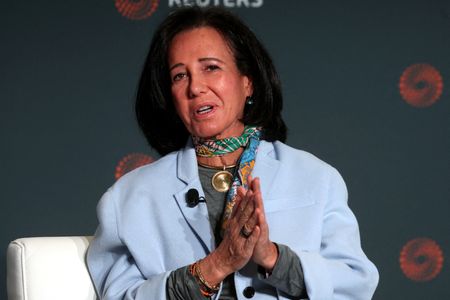By Jesús Aguado and Tommy Reggiori Wilkes
MADRID/LONDON (Reuters) – Spanish banker Ana Botin set about transforming Santander, a sprawling, acquisition-obsessed and fragmented lender into a leaner, simpler global bank as soon as her father’s sudden death thrust her into the role.
A decade on, it’s still a work in progress.
Santander shares have fallen more than 30% since she became executive chair in September 2014, the fourth generation of Botin to run the lender, and several people familiar with her thinking say she remains frustrated at the value investors have placed on the now third-largest euro zone bank by market capitalisation.
Botin, 63, one of few women at the top of global finance, has no plans to call it a day and is instead pursing her plan to transform Santander into a global financial platform properly appreciated by investors, the people said.
“She inherited an institution with a tremendous tradition, but that wasn’t really ready for the modern global regulatory environment,” Larry Summers, former U.S. Treasury Secretary who Santander appointed in 2016 to chair an international advisory board, told Reuters.
“Part of Ana’s strength is that she’s never satisfied. She always thinks that the bank can do better,” he said.
Botin remains one of the world’s best-connected bankers, building on relations her late father forged as he trawled the world for deals.
“She’s got options on whether she concentrates more on a single market or whether she continues to run a diversified strategy. But that diversified strategy is where she is now. And she’s not being recognised for that business mix at the moment,” said Standard Chartered boss Bill Winters, who has known Botin for nearly 40 years.
She has previously defended her record, noting that shareholder returns have risen six-fold and that the bank should end 2024 with a record profit. She has overhauled management, with more than half of senior managers no longer Spanish – down from almost none when she took over.
But on the simplest measure of performance, it’s not gone so well. Since Sept. 9 2014, Santander stock has fallen 35%, the STOXX Europe 600 Banks index has fallen 2%. Shares in arch-rival BBVA have gained 3%.
Santander declined to comment.
Bank insiders say performance looks far better when including dividends and buybacks and note that Botin was forced to make a share-weakening 7.5 billion euro ($8.3 billion) capital hike within months of starting. European banking stocks in general have been unpopular in the last decade, they add.
Davide Serra, founder of Algebris Investments, which owns Santander stock and bonds, credits Botin with taking an empire built by her father and trying to integrate its fragmented parts.
“The project is never-ending,” he said. “In three, five years’ time, we will have a view of where this integration process will lead us.”
FAMILY FOOTSTEPS
As a child, Botin dreamed of becoming a journalist or even a spy, but her father and grandfather meant finance was never far from her mind.
“The two of them would meet on their own and I would join them. I always listened and talked a lot about finance”, Botin said in an interview posted on Santander’s website this week.
Ambitious and competitive according to people close to her, Botin, a mother of three, has suffered setbacks, not least the bruising battle over a withdrawn CEO offer to Italian banker Andrea Orcel.
The 2018 appointment triggered confusion about why an investment banker would run a retail lender, forcing Botin to defend the move and eventually U-turn. Santander was ordered to pay Orcel millions in compensation.
“The Orcel case was a matter of pure egos, a fiasco and was not managed well at all,” said Enrique Quemada, chairman of Madrid-based ONEtoONE Corporate Finance Group.
Her family’s outsize presence at Santander, where its shareholding is only about 1.2%, has raised corporate governance concerns, although executives say she has modernised it.
And while her rise to the top may have seemed inevitable, her father once asked her to leave because she was considered an obstacle for a 1999 merger with Banco Central Hispano.
She left, but was back three years later.
NEXT CHALLENGE
Her big bet now is that a simpler structure of five units serving customers globally, rather than a disparate set of regional or country-specific approaches, will boost profits.
Botin has also pledged to keep Santander growing in the U.S., a market where European rivals have retrenched or pulled out.
She told Reuters in June the U.S. would be the launch pad for a revamped technology platform eventually serving consumer customers globally.
“She made a very smart decision staying in the U.S. This is the biggest market in the world, and I think some people had to sell their U.S. subsidiaries, but she’s got a good platform here,” JP Morgan CEO Jamie Dimon, who knows Botin well, told Reuters.
Still, some question her approach.
“Santander is just a very small player and the strategy does not look that clear to me apart from building a potential bridge with Latin America or wealthy clients in Miami”, said Nicolas Lopez, Singular Bank’s head of equity research.
Investor support for Botin remains strong – shareholders convincingly backed the last vote on her re-election as executive board member – and there are no plans yet for a successor, according to Santander insiders and bankers familiar with the situation.
($1 = 0.9069 euros)
(Reporting by Jesús Aguado in Madrid and Tommy Reggiori Wilkes in London; Additional reporting by Emma Pinedo Gonzalez; Editing by Alexandra Hudson)





